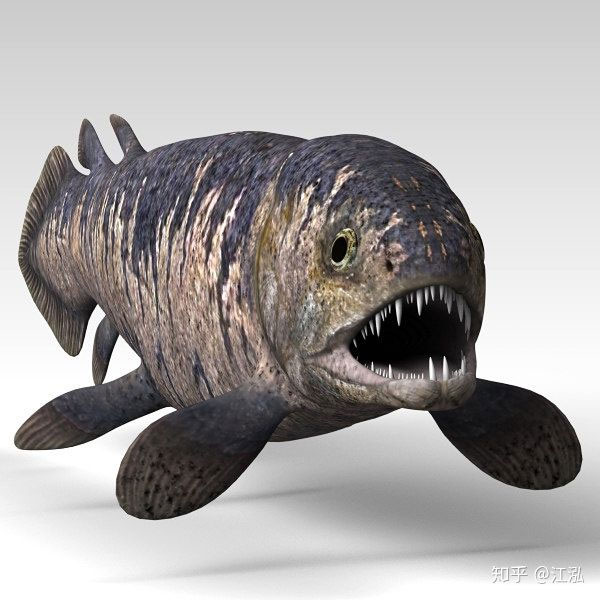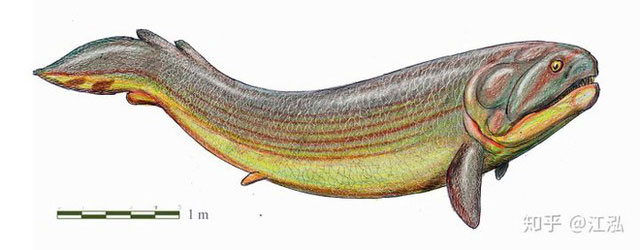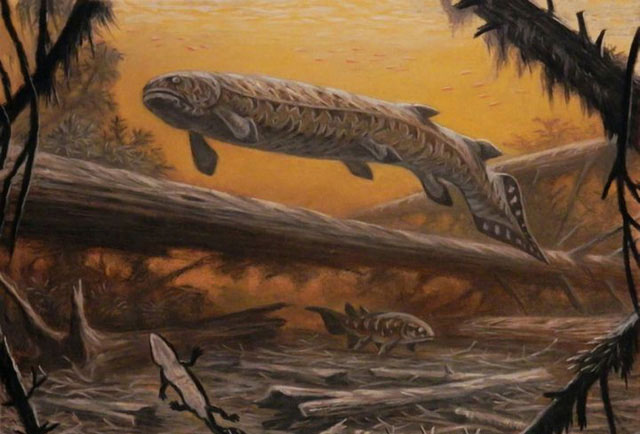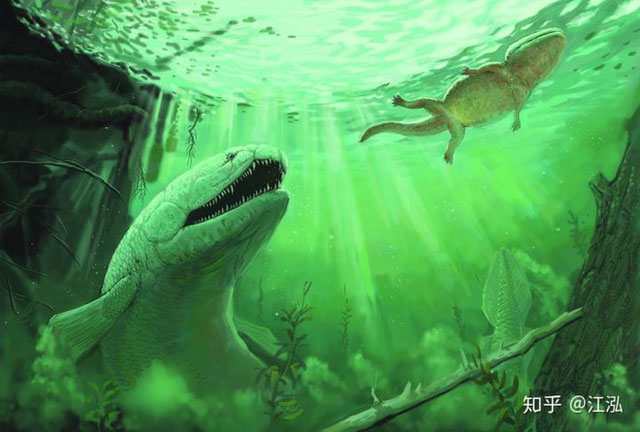Rhizodus hibberti: Horror monster of the Carbon era
When it comes to the Carbon Age, people will immediately think of it as the era of giant insects like meter-long arthropods, large dragonflies like birds, but in reality The most terrible "killer" of the Carbon era is not a land or sky creature, because they are simply giant predators lurking on the bottom of rivers and lakes. One of them is the famously ferocious fish - Rhizodus hibberti.

Rhizodus hibberti - a giant predator fish lurking on the bottom of a lake.
These giant freshwater inhabitants are the largest freshwater predators ever known. While many modern giant fishes are gentle giants like giant sharks and rays, these giant Rhizodonts are very violent in their behavior. The main food of these Rhizodonts is large prehistoric fishes and giant amphibians.
In the early 19th century - it was an important period for paleontologists. Cuvier and Irvine, along with other pioneers in paleontology, examined the fossils they found with their own knowledge and named a range of ancient species such as lizards. Meuse, dragon, Megatherium ...
In Scotland, several fossils of teeth have been found, some of which are even more than 20 cm long. At that time, they were still unable to determine which ancient long tooth belonged to which ancient creature. But soon after Irvine looked at the fossilized tooth, he determined that the fossil teeth belonged to a prehistoric fish, so he named it Rhizodus with the scientific name. full Rhizodus hibberti.

Fossilized teeth fossils of cad Rhizodus hibberti.
Through many analysis and research, paleontologists were also able to determine their exact size, Rhizodus hibberti are very large, their bodies can be longer than 7 meters and weigh 2 tons. , bigger than the great white shark still living in our oceans today. And it is very likely that the Rhizodus hibberti is the exaggerated version of today's lungfish.

Actual size when compared to humans.

Rhizodontida (meaning root teeth) is a set of four-legged lobe finfish living during the Givet stage to Pennsylvania in many parts of the world - the oldest known species appeared about 377 million years ago (Mya), The last species is around 310 Mya. Rhizodontida lived in tropical rivers and freshwater lakes, and were predatory predators at the time. They reach a large size - the largest known species, Rhizodus hibberti in Europe and North America, is estimated to be 7 meters long.
The head of this fish is about 1 meter long, they possess large round eyes in front of the top of the head. These eyes allow them to have a great view so they can hunt and see prey in the cloudy water.
Rhizodus hibberti has a large mouth under the eyes filled with sharp and curved teeth. They own "super-large" front teeth with a length of up to 22 cm and in the oral cavity are innumerable smaller and pointed teeth. From the teeth that archaeologists unearthed, it can be seen that their main food was ancient catfish and amphibians in the same period.

Rhizodus hibberti has a large mouth under the eyes filled with sharp and curved teeth.
Fossils of this terrible creature found in Europe and North America, are preserved when the environment of rivers and lakes sedimentary. The teeth of this species include a lot of small teeth with extremely strong and sharp structure along with many cutting teeth. Each tooth is firmly anchored in the jawbone and when compared, this jaw is far more terrible than modern sharks.
The body of this giant freshwater fish is quite round and full, looks quite similar to the torpedoes covered with hard scales throughout the body.
They also possess a pair of pectoral fins as well as a pair of pelvic fins and fins to protect the anal area, possessing a tail similar to today's lung fishes. The streamlined shape and body along with the strong caudal fin can give them enormous speed in the Carbon-era water environment.

Rhizodus hibberti lived during the Carboniferous - Carbon Age - when the earth was called the era of insects. During the Carbon period, the Earth was covered with a large amount of trees and plant photosynthesis gave our planet a huge amount of oxygen (up to 35%), which also created conditions Allow giant creatures to appear. If on the ground and in the air is the paradise of insects, in the lush swamp forests, the bottom of the lake and lake is the kingdom governed by the dominance of the fish Rhizodus hibberti.

Rhizodus hibberti, they attack all the animals that appear in their sight, whether it is fish or amphibians.
Lurking in the murky waters is the Rhizodus hibberti, which attacks all the animals that appear in their sight, whether it is fish or amphibians. Heath Rootfish's attack is fierce and bloody. They will grab the prey with long, sharp front teeth and swallow the prey into the abdomen.

Heath Rootfish's attack is fierce and bloody.
The characteristic of Rhizodus hibberti is that the fins have fins and bones supporting them inside, they are very large and strong, but the fate of this fish could not escape the extinction of the Carbon. Although extinct, Heath Rootfish is still one of the largest carnivorous fish that has ever lived in fresh water on Earth.
The characteristic of Rhizodus hibberti is that the fins have flesh fins and bones that support them inside.
- Unexpected facts about dolphins that few people know
- Climate change changes the pH of the ocean, returning to what it was 14 million years ago
- Decipher the mystery: An extremely ugly, scary monster is called a "living fossil"
- Discover the secret about the octopus - The "monster" of the sea
- Spectacular surreal scenes "dolphins glow" under the sea
FIDITOUR TRAVEL COMMUNICATION COMPANY
Representative: Mr. Tran Van Long - Chairman and General Director
Head office: 95B-97-99 Tran Hung Dao, District 1, City. Ho Chi Minh.
Hanoi Branch: 66 Tran Hung Dao, Hoan Kiem District, Hanoi
Phone: 028 730 56789 | Hotline: 19001177